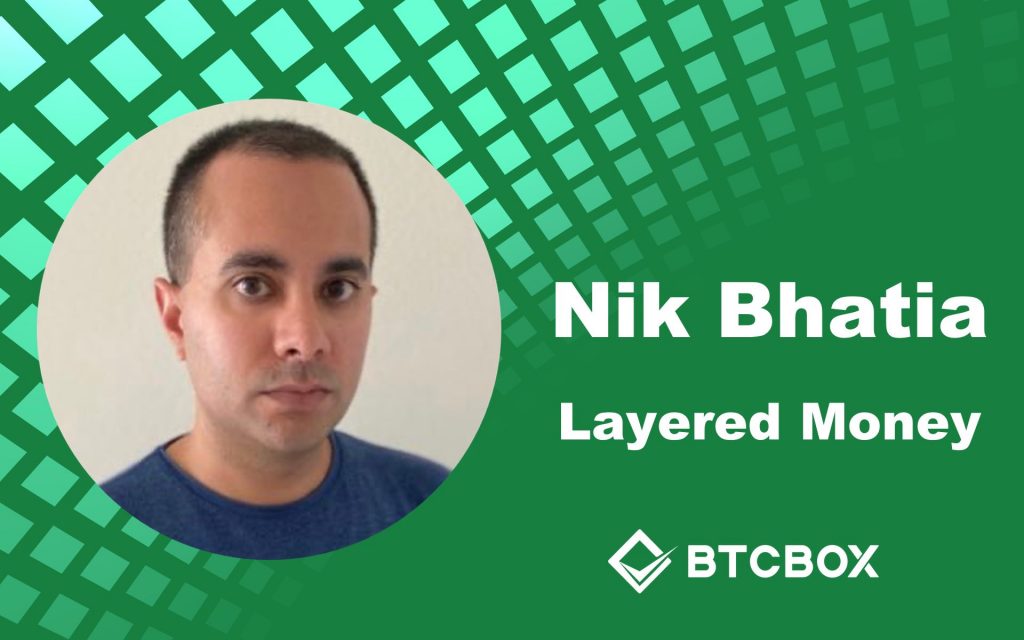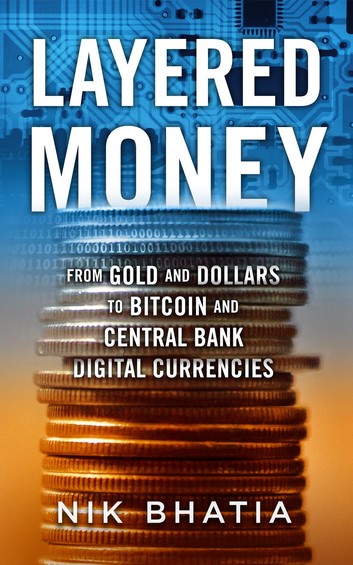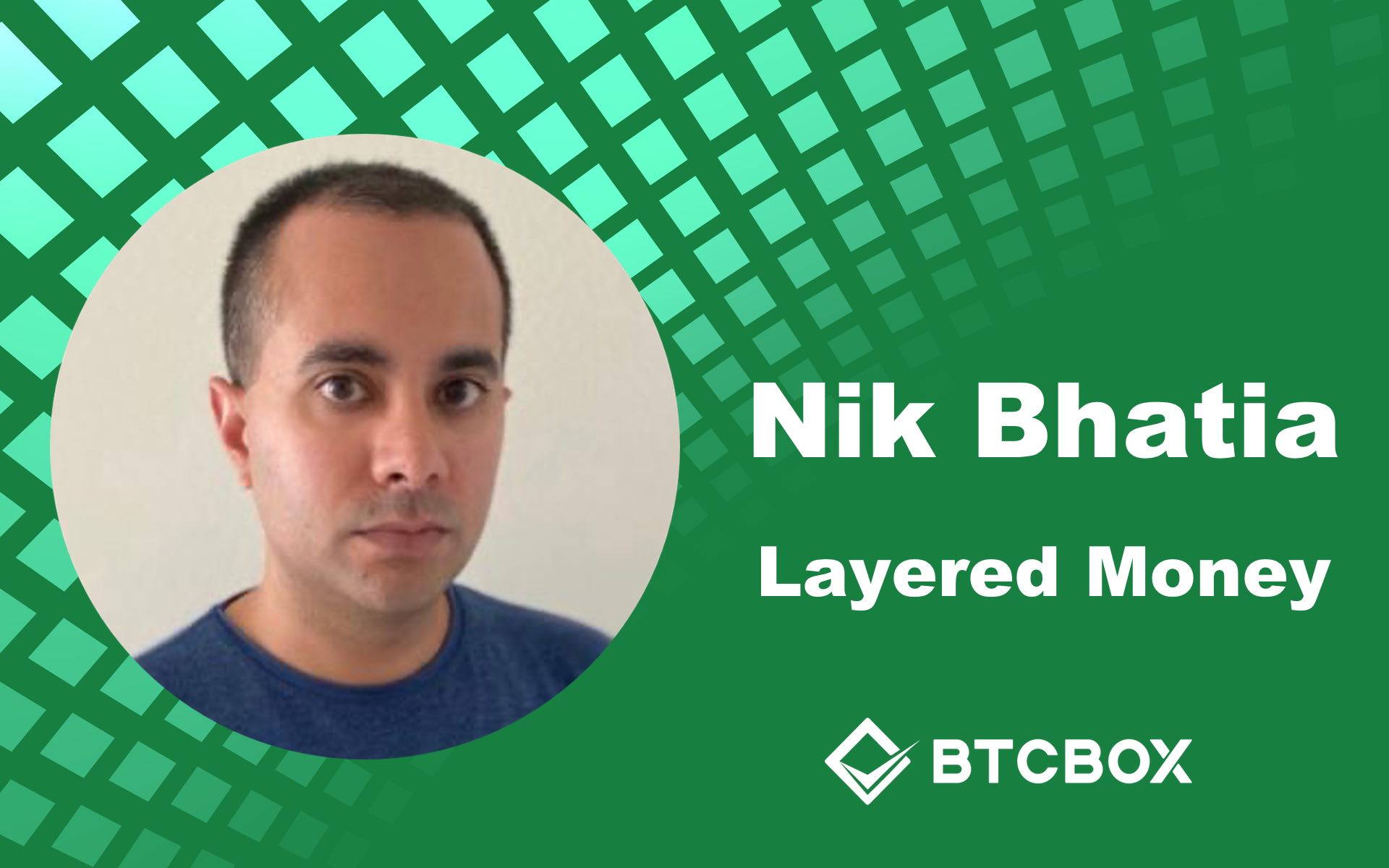
Nik Bhatia is the author of Layered Money: From Gold and Dollars to Bitcoin and Central Bank Digital Currencies. Previously, he was a trader of US treasuries at a large investment management company in California, and his job was to both trade interest rate products and help set strategy for clients. Nik Bhatia is a former Wall Street trader, adjunct professor at the University of Southern California Marshall School of Business, and a private asset counselor. He helps onboard to Bitcoin both in a retail and institutional setting. He is also a counselor for investment managers with clients that are demanding a solution to get allocated to Bitcoin.
Interview Date : 3rd February 2021
How did you come to write Layered Money?
Layered money is another way of saying that we are in a credit money system, meaning, those forms of money that everyday people use are all forms of credit. They’re a liability of some financial institution issued to us as a debt instrument or credit instrument. For example, a checking account has dollars or yen in it called a deposit. The deposit is on the liability side of the Banks balance sheet. In the context of layers of money, the bank deposit that everyday people have is actually on the third layer of money. The second layer of money would be the central bank’s liabilities, for example, the Bank of Japan’s reserves in the system which are the assets of the private banking system.

The first layer of money would be JGBs (Japanese Government Bonds) where the government bonds are the assets backed by the central banks. So, government bonds become the first layer of money.
I didn’t write it for people that already believe in Bitcoin necessarily. I wrote this book for people that are interested in Bitcoin, and especially people that have a background in traditional finance. So, I’ve written a book in their language to explain why Bitcoin is an exciting part of our monetary future.
Why do you explain it as layers of money?
It is to show that in the past gold, and today and in the future Bitcoin are both first-layer monies. They don’t originate from the balance sheet of a financial institution. They are commodities and assets, not liabilities. Cash deposits are all liability forms of money, so your PayPal balance and any other deposit account are electronic interfaces where we interact with dollars or yen. Bitcoin, just like gold, is not the liability of anybody. Now, if you have a balance on a Bitcoin exchange, you are on a second layer Bitcoin because you don’t own the Bitcoin yourself, you own the liability of the Bitcoin exchange. Thus, Bitcoin still can have a layered structure to it. However, the very unique thing about Bitcoin is that anybody can have access to the first layer of money.
Why is it important to have access to the first layer of money?
Because you don’t have to be in a situation where you have to trust any counterparty. For example, if you are holding a bank deposit, you have to trust that the bank will not fail. If your deposit is insured by your government, you have to trust that if the bank fails the government will pay you out an insurance claim. Therefore, if you hold paper money that is a liability of the central bank and the government, you have to trust that your money is going to have value in the future. This is not to say that government currencies are bad and Bitcoin is good, it’s saying that people will, and they already are, demanding an alternative to holding money that is a liability of a government or a central bank. They prefer the option to have the freedom to denominate their earnings and their savings in a currency that doesn’t rely on anybody.
Wouldn’t there be chaos if everyone was their bank?
I do believe that most people will not take custody of their Bitcoin or be entirely in control of their savings and monetary future. They will continue to trust banks, governments, financial institutions, and financial technology companies to do that for them because people like insurance. People like having a mechanism to recover if they lose or misplace their assets. For that reason, not everyone is going to take control of their money on the first layer in the future. I do believe that a layered money structure is quite natural where some will demand a counterparty free money and others will be consenting to trust a bank or a government to take custody of their money.
What is Bitcoin about?
It is all about the freedom to choose, and you should be able to choose two things at once as well. If you want to hold half of your wealth in dollars and half of it in Bitcoin, you should be free to do so. It is not to say that Bitcoin will replace all currencies of governments and take banks out of the equation completely. Bitcoin is just a choice and people are using Bitcoin as that alternative today. I believe that’s a trend that will continue.
How did a layered structure of the monetary system start?
Gold and silver have been used as money by human beings for thousands of years, but in the 13th century, some city republics in northern Italy, such as Florence and Venice, issued a gold coin by their mint that had been changed to purity. This was unprecedented and such an event had never happened before where a coin had such stability and a government didn’t devalue the currency like it had done in the past, such as during the Roman Empire and the Greek city-states. Because of the stability of the Gold Florin, the coin of Florence, and also the gold Ducat in Venice, this new class of merchant bankers started to issue promises to pay Florin and Ducat. People held these promises as if they were money. So, for the first time, you had this layered situation where the first layer of money was the gold coins that had stability and the second layer was the promise to pay the first layer of money. However, that deferred settlement was trusted. There was a culture of trust that started to develop in Europe where bankers were willing to issue these promises to pay and people were going to accept them. That situation gave birth to this layered money system that we live in today.
How does the dollar work today?
In 1971, the United States removed gold from its currency’s convertibility, meaning, gold was removed as the first layer of money in the framework and the government currency stood on its independent of the historical anchor to the whole system for the first time. That is the system that we still live in today. It is its asset. People still gold and demand it, and the gold price has been doing quite well over the last decade. Just like gold, neither is Bitcoin in our monetary system. We can transition to a world where Bitcoin is at the top of the new digital layered money system, and that is developing, but the size of that system is still quite small relative to the traditional dollar system. I think it will be a lot more gradual, and it will co-exist with government currencies.
What is the current trend of interest rates?
I wrote my thesis on where interest rates are going in the United States and I was very vocal in my prediction that rates are headed to a significantly lower number in the coming years. We are amidst a 40-year trend downward in interest rates for government bonds around the world. Japan, Germany, and the United States all have extremely low-interest rates. Japan reached those lows earlier than the rest and the rest of the western world did. And I realized why Bitcoin and gold were being demanded and their prices were going up. I transitioned to a thinking framework in which Bitcoin was amidst gold and US treasuries as the 3 most desired assets in the world going forward for the next 10 years.
Can we predict inflation if interest rates are lowered?
Predicting that inflation is coming because interest rates are low is something that has proven to be ineffective for several years. We don’t see inflation even though rates have been 0 or negative in most of the developed world for the last several years. Inflation does not get off the ground in Europe, Japan, and the United States. Real estate and many other different assets are used by people to hedge way inflation. However, asset classes like gold, art, and even classic cars are used like that as well. There are forms of equity-ships in certain entities that resemble this wealth preservation. When you see billionaires from Russia purchasing Apartments in London, paintings by Picasso, and shares in JPMorgan Chase, they’re trying to diversify their wealth in many ways which they feel will preserve their purchasing power in the long run. So, one cannot afford to look at this narrowly. Bitcoin has very much officially joined that club of real estate, fine art, Classic cars, and prime equity positions in the United States and other western-based domiciled corporations.
How much bigger can Bitcoin grow with respect to Gold?
So far, only companies like Apple and Amazon are in that realm of 1 trillion-dollar evaluation, and gold is approximately a $10 trillion asset around the world. So, as Bitcoin approaches a $1 trillion market cap, it’s already reaching 10% of the size of gold that warrants it being in the same conversation.
Why does Bitcoin not have Time Value?
Bitcoin not having time value is the same thing as gold. If you hold a gold-bar in your pocket or a vault somewhere, that gold is not accruing any income to you. You are likely paying to have it stored properly. So, you have what we call a Negative Income associated with holding gold. Now, if you have a US government bond that still has a positive interest rate, any share inequities, or an apartment building, you have income coming towards you. You may have interest income, dividend income, or rental income, meaning you have the time value of money occurring to you with these other asset classes. Gold nor Bitcoin do have that. Bitcoin itself does not have any accrual function where you can earn with the Bitcoin itself. Rather, if you are to hold Bitcoin properly and securely yourself, you are likely spending money on equipment and security for that which would be a theoretical negative income, thus Bitcoin does not have time value.
Interviewer , Editor : Lina Kamada
【Disclaimer】
The Article published on this our Homepage are only for the purpose of providing information. This is not intended as a solicitation for cryptocurrency trading. Also, this article is the author’s personal opinions, and this does not represent opinion for the Company BTCBOX co.,Ltd.


